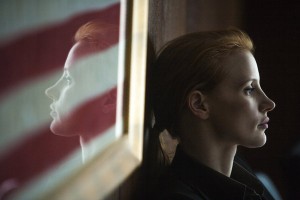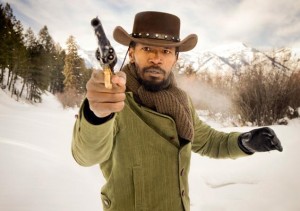Topics:
Search for topics or resources
Enter your search below and hit enter or click the search icon.
January 16th, 2013 | 7 min read

Of all the 2012 films nominated for best picture Oscars this year, two have gained press as much for their controversial content as for their awards-caliber quality. Those two films are Kathryn Bigelow’s Zero Dark Thirty and Quentin Tarantino’s Django Unchained.
The former, a tense action thriller documenting the CIA’s decade-long search for Osama bin Laden, has proven controversial because of its hard-to-watch depiction of “enhanced interrogation techniques” (aka torture) early in the film. The latter, a revisionist pop art spaghetti western about a slave uprising in the Antebellum South, has raised eyebrows because of its over-the-top violence, racially offensive language (over 100 uses of the “n” word), and generally irreverent treatment of a sensitive topic.
 The Zero Dark Thirty controversy is a murky one, with accusations claiming either that the film dangerously misleads in its depiction of torture (Senators John McCain, Carl Levin and Dianne Feinstein are leading this charge) or that it gets the facts mostly right and is well within the latitude usually afforded the “based on a true story” Hollywood genre. In his lengthy defense of the film in The Atlantic, Mark Bowden writes,
The Zero Dark Thirty controversy is a murky one, with accusations claiming either that the film dangerously misleads in its depiction of torture (Senators John McCain, Carl Levin and Dianne Feinstein are leading this charge) or that it gets the facts mostly right and is well within the latitude usually afforded the “based on a true story” Hollywood genre. In his lengthy defense of the film in The Atlantic, Mark Bowden writes,
Torture may be morally wrong, and it may not be the best way to obtain information from detainees, but it played a role in America's messy, decade-long pursuit of Osama bin Laden, and Zero Dark Thirty is right to portray that fact.
Critics on the other extreme, like The Guardian’s Naomi Wolf, accuse Bigelow of nothing less than deception and propaganda, comparing her to famous “facts”-benders like James Frey and Leni Riefenstahl.
In her acceptance speech for best director at the January 7 New York Film Critics Circle Awards, Bigelow defended the film against such attacks by saying:
I thankfully want to say that I'm standing in a room of people who understand that depiction is not endorsement, and if it was, no artist could ever portray inhumane practices; no author could ever write about them; and no film-maker could ever delve into the knotty subjects of our time.
Though Django Unchained exists in an entirely different universe than Zero Dark Thirty (a much more cartoonish, stylized universe), presumably Quentin Tarantino would echo Bigelow’s sentiment that what a filmmaker depicts in his or her films should not be assumed to be endorsement. For Tarantino, who has since the days of Pulp Fiction and Reservoir Dogs been something of a scapegoat/posterboy for the societal hazards of violent cinema, the “depiction is not endorsement” defense is a crucial one. But is it ironclad?
 In a recent interview with a British journalist who tried to press Tarantino on the question of the relationship between movie violence and real violence, Tarantino went a little bit crazy, saying “I'm not your slave, and you're not my master," as he repeatedly refused to answer any questions on the subject. Clearly (and perhaps tellingly) Tarantino was uncomfortable with the topic. Watch the amusing clip here.
In a recent interview with a British journalist who tried to press Tarantino on the question of the relationship between movie violence and real violence, Tarantino went a little bit crazy, saying “I'm not your slave, and you're not my master," as he repeatedly refused to answer any questions on the subject. Clearly (and perhaps tellingly) Tarantino was uncomfortable with the topic. Watch the amusing clip here.
In the wake of the Newtown and Aurora massacres, when questions about the role of desensitizing movie and video game violence seem reasonable if not obligatory, it seems that the burden is on filmmakers like Tarantino to at least ponder the question.
In an interview this month with NPR, Tarantino sort-of addresses the subject of violence and exploitation in Django:
What happened during slavery times is a thousand times worse than [what] I show. So if I were to show it a thousand times worse, to me, that wouldn't be exploitative, that would just be how it is. If you can't take it, you can't take it. … Now, I wasn't trying to do a Schindler's List you-are-there-under-the-barbed-wire-of-Auschwitz. I wanted the film to be more entertaining than that. ... But there's two types of violence in this film: There's the brutal reality that slaves lived under for ... 245 years, and then there's the violence of Django's retribution. And that's movie violence, and that's fun and that's cool, and that's really enjoyable and kind of what you're waiting for.
But that’s precisely the troubling thing about movie violence. As fantastical and as clearly “movie-fake” as it might be, it is so often tied up with the emotional arc of a character we are rooting for or a justice we are vicariously hoping to experience. These are Tarantino films in a nutshell: Kill Bill, Inglourious Basterds, Django Unchained, Death Proof. They are revenge fantasies, hypothetical alternate histories in which terrible killers are vanquished with samurai swords, theaters full of Nazis are destroyed by Jews, and evil slaveowners like Calvin Candie (Leonardo DiCaprio) are terminated by lowly slaves. The violence in these movies is embarrassingly, unnervingly enjoyable because it is employed in the service of a juicy, attractive tale of (mostly) good overcoming evil.
Even when movie violence is gritty, ugly and un-romanticized (as in Zero Dark Thirty), it has a potency that attaches itself to our emotions and causes us to more or less cheer it on. Critic David Edelstein named ZDT the best film of the year but nonetheless finds himself unnerved by some of these questions: “In cinema,” he writes, “the adrenaline rush can overwhelm our squeamish objections to violence. That’s what makes the medium so dangerous. … Bigelow doesn’t just depict the hunt for and killing of Osama bin Laden. She puts it into our bloodstream.”
But is it really the filmmaker’s responsibility to account for the affective, intoxicating power of cinema? Must a filmmaker worry about what others feel, or in extreme cases are inspired to do, because of what they see in a film?
From some angles, the suggestion that artistic depiction is endorsement appears ludicrous. A cursory survey of art history reveals as much. Caravaggio was clearly not endorsing the behavior of the Roman soldiers in his paintings of Christ’s passion, for example. And then there’s the entire tradition of social realist art which intends depiction for the very opposite of endorsement: for chastisement or expose. Courbet’s The Stone Breakers and any number of Ken Loach films, for example, do not depict poverty and inequality so as to endorse their existence; rather they depict them to bring awareness to egregious conditions and abominable injustices.
But the depiction of “the ugly” in art as means to bring about reform is one thing. Should artists be given free pass to depict the extremes of ugliness (torture, unspeakable gun violence, hundreds of uses of the “n” word) when their only purpose is to convey a purported verisimilitude to the “reality” of the world in which their story is set?
In short, yes. I believe that insofar as an artist honestly sets out to tell a story that is truthful (to the world in which it is set, to the real struggles of its characters), then it is their right and even obligation to not shield us from the darker elements. As I wrote recently in Relevant Magazine, “Something about the way the world is (that is: difficult, risqué, R-rated) tells us that to be truthful, art must grapple with darkness. As filmmaker Akira Kurosawa once said, ‘The artist is the one who does not look away.’”
For me, it all comes down to whether the artist is in the business of seeing the world more clearly and thus focusing the audience’s gaze on a reality in the truest since. This would exclude artists and filmmakers who use depiction and all of its accompanying visceral pull to twist reality and tell propagandistic lies (e.g. Leni Riefenstahl), as well as those who use depiction not to guide the viewer toward contemplation of truth as much as to be provoked, grossed out, titillated or otherwise distracted (e.g. “torture porn” directors like Eli Roth, shock-artists, etc.)
In the case of the two films under discussion in this essay, I’d say Bigelow’s Zero Dark Thirty fairly passes the test. However foggy the history may be in her narrative of the hunt for “UBL,” it’s clear that her intention is not propagandistic or sensationalist. Tarantino’s Django is a bit of a harder case, because everything about it screams sensationalism and maybe even exploitation. It’s less clear whether Tarantino’s aim here is wholly oriented toward truth-telling (as opposed to merely a stylish exercise in genre and pop culture pastiche), but I’m going to go out on a limb and give Quentin the benefit of the doubt.
His film is not a ripped-from-the-headlines true story like Zero Dark Thirty. But in spite of its flamboyance, the world of Django--the passions, atrocities, hatred, fear, vengeance, occupations, camaraderie--rings true. And the same painstaking, sometimes dirty quest for the destruction of a villain that drives Zero Dark Thirty also drives Django. It’s Hollywood, and it’s life.
And that’s precisely why cinema is at once a powerful, beautiful artform but also something that troubles the waters of our scapegoat-seeking, hyper-violent culture. Cinema tells the truth like nothing else because it sticks like nothing else; as Edelstein noted, it “gets into our bloodstream.” It gets our heart pumping. Cinema is powerful because it is dangerous.
Or maybe it’s the other way around.
Brett McCracken is a Los Angeles-based journalist. He is the author of Hipster Christianity (2010) and Gray Matters (2013), and has written for the Wall Street Journal, the Washington Post, CNN.com, the Princeton Theological Review, Mediascape, Books & Culture, Christianity Today, Relevant, IMAGE Journal, Q Ideas, and Conversantlife.com. A graduate of Wheaton College and UCLA, Brett currently works as managing editor for Biola Magazine and teaches at Biola University. Follow him on Twitter @brettmccracken.
Topics: